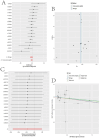Single-cell transcriptomic landscape reveals complex cellular heterogeneity and dysregulated signaling pathways in nasopharyngeal carcinoma
- PMID: 40389670
- PMCID: PMC12089554
- DOI: 10.1007/s12672-025-02506-2
Single-cell transcriptomic landscape reveals complex cellular heterogeneity and dysregulated signaling pathways in nasopharyngeal carcinoma
Abstract
Background: Nasopharyngeal carcinoma (NPC) is a common malignancy with a complex pathogenesis and diverse cellular composition. This study aimed to systematically analyze the transcriptional characteristics of different cell types in NPC and their roles in tumor development using single-cell transcriptomics.
Methods: The research team collected NPC and normal tissue samples, and performed in-depth single-cell sequencing analysis of the transcriptomes. Single-cell RNA sequencing was performed on the collected samples to obtain high-resolution transcriptional profiles of individual cells. This allowed the researchers to identify and characterize the diverse cell populations present within the NPC tumor microenvironment.
Results: The results showed that NPC samples contained multiple distinct cell subpopulations, including epithelial cells, immune cells (such as macrophages and T cells), endothelial cells, and stromal cells. These cell types exhibited marked differences in spatial distribution and transcriptional profiles, reflecting the high degree of heterogeneity within the tumor microenvironment. Further functional analysis revealed significant dysregulation of mitochondrial-related pathways, extracellular matrix-receptor interactions, as well as Wnt, Notch, and other signaling cascades in NPC.
Conclusion: This study employed single-cell transcriptomics to comprehensively elucidate the complexity of the NPC tumor microenvironment, providing new insights into the underlying mechanisms of disease pathogenesis and suggesting potential therapeutic targets. These findings lay the groundwork for the development of precision medicine approaches for NPC.
Keywords: Cellular heterogeneity; Nasopharyngeal carcinoma; Signaling pathways; Single-cell transcriptomics; Tumor microenvironment.
© 2025. The Author(s).
Conflict of interest statement
Declarations. Competing interests: The authors declare no competing interests.
Figures








Similar articles
-
KMO-driven metabolic reconfiguration and its impact on immune cell infiltration in nasopharyngeal carcinoma: a new avenue for immunotherapy.Cancer Immunol Immunother. 2025 Feb 1;74(3):75. doi: 10.1007/s00262-024-03928-7. Cancer Immunol Immunother. 2025. PMID: 39891699 Free PMC article.
-
Single-cell analysis reveals the multiple patterns of immune escape in the nasopharyngeal carcinoma microenvironment.Clin Transl Med. 2023 Jun;13(6):e1315. doi: 10.1002/ctm2.1315. Clin Transl Med. 2023. PMID: 37349991 Free PMC article.
-
Single-cell transcriptomics reveals regulators underlying immune cell diversity and immune subtypes associated with prognosis in nasopharyngeal carcinoma.Cell Res. 2020 Nov;30(11):1024-1042. doi: 10.1038/s41422-020-0374-x. Epub 2020 Jul 20. Cell Res. 2020. PMID: 32686767 Free PMC article.
-
Revealing the crosstalk between nasopharyngeal carcinoma and immune cells in the tumor microenvironment.J Exp Clin Cancer Res. 2022 Aug 13;41(1):244. doi: 10.1186/s13046-022-02457-4. J Exp Clin Cancer Res. 2022. PMID: 35964134 Free PMC article. Review.
-
The Stromal and Immune Landscape of Nasopharyngeal Carcinoma and Its Implications for Precision Medicine Targeting the Tumor Microenvironment.Front Oncol. 2021 Sep 10;11:744889. doi: 10.3389/fonc.2021.744889. eCollection 2021. Front Oncol. 2021. PMID: 34568077 Free PMC article. Review.
References
-
- Chen L, Li J, Li K, Hu J, Li Q, Huang C, Wang G, Liu N, Tang L. Corrigendum to “Evaluation and analysis of risk factors of hearing impairment for nasopharyngeal carcinoma treated using intensity-modulated radiotherapy” [Radiother. Oncol. 190 (2024) 109985]. Radiother Oncol. 2025;204: 110719. - PubMed
-
- Xiao Z, Chen W, Du Y, Zeng F, Su F, Huang S, Qu S. Efficacy and safety of Anlotinib in combination with gemcitabine and cisplatin as a first-line treatment for recurrent or metastatic nasopharyngeal carcinoma: a single-arm clinical trial. Int J Cancer. 2025;156(11):2169–77. - PubMed
LinkOut - more resources
Full Text Sources
